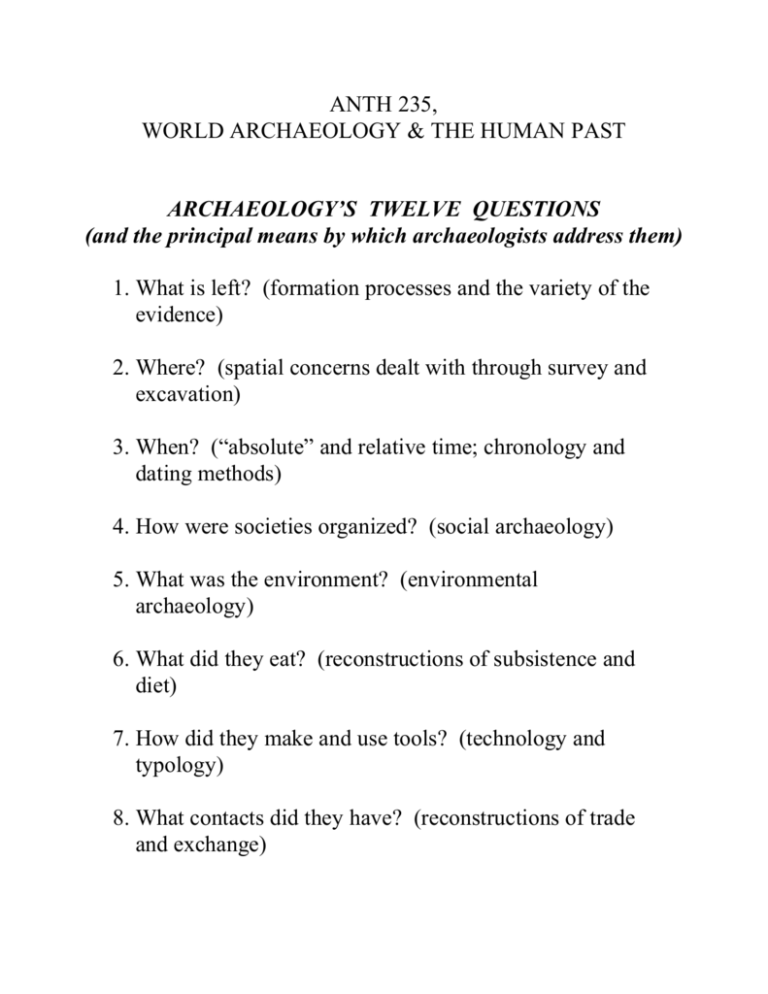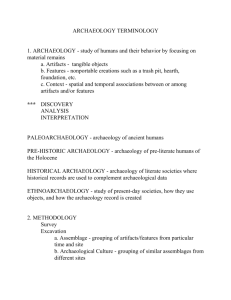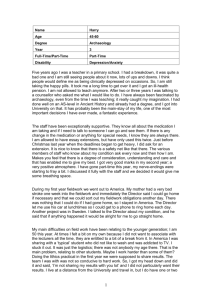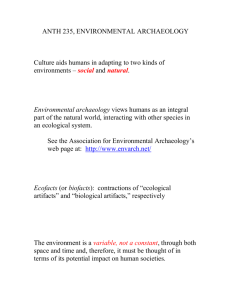ANTH 235, SUMMARY AND PROSPECTS
advertisement

ANTH 235, WORLD ARCHAEOLOGY & THE HUMAN PAST ARCHAEOLOGY’S TWELVE QUESTIONS (and the principal means by which archaeologists address them) 1. What is left? (formation processes and the variety of the evidence) 2. Where? (spatial concerns dealt with through survey and excavation) 3. When? (“absolute” and relative time; chronology and dating methods) 4. How were societies organized? (social archaeology) 5. What was the environment? (environmental archaeology) 6. What did they eat? (reconstructions of subsistence and diet) 7. How did they make and use tools? (technology and typology) 8. What contacts did they have? (reconstructions of trade and exchange) 9. What did they think? (cognitive archaeology) 10.Who were they and what were they like? (recognizing the individual in prehistory) 11.Why did things change? (explanation in archaeology) 12.Whose past is it? (archaeology and the public) Archaeology can be made to serve many masters: economic ends (tourism, land-use & agricultural strategies – cautionary tales from the past) nationalistic & political agenda (potential positive & negative aspects of both) the past can be sold to a willing public (satisfying the basic human “backward-looking curiosity”) The Indiana Jones Snack Shop & “Gifts Shop” Petra, Jordan (2008) “World archaeology” is something in which we can all share; for example: the human origins revealed in Africa are the origins of us all since ultimately we’re all of African descent archaeology can document the trajectory of growth of every population on Earth, regardless of age, ethnicity, or lack of historical documentation Although many earlier scholars did indeed behave with flagrant disregard for the feelings and beliefs of native peoples (and, sadly, some continue to do so!), interest in these matters today is not some neocolonial attempt to further appropriate the native past. If we are to have an accurate perception of our place as human beings in the modern world, then the past matters. Should Erich von Däniken, author of Chariots of the Gods?, be taken seriously? After all, von Däniken’s 23 books have sold over 56 million copies worldwide and have been translated into 28 languages, making him one of the most successful “nonfiction” writers of all time! See: http://www.daniken.com/ Erich von Däniken at Dendera, Egypt Heritage studies have become an integral component of modern archaeological analyses. For additional background, see: Smith, Laurajane 2004. Archaeological Theory and the Politics of Cultural Heritage. New York & London: Routledge. 2006. The Uses of Heritage. New York & London: Routledge. In the related realm of activist archaeology, see also: McGuire, Randall H. 2008. Archaeology as Political Action. Berkeley: University of California Press. Although the immediate aim of most research is to answer specific questions, the fundamental purpose of archaeology must be to provide people in general with a better understanding of the human past. Obviously, archaeologists can’t study that which no longer exists… Stele of an Assyrian king stolen from the Iraq National Museum in the looting that accompanied the liberation of Baghdad in 2003. It is still unaccounted for. Space: The New Frontier…for Archaeologists Some might think that the 27,000 tons of material launched by earthlings into space is nothing more than floating piles of debris. However, when looking at these artifacts through the eyes of archaeologists, they are seen as links to human history and heritage, not merely celestial pollution. Darrin, Ann Garrison and Beth Laura O’Leary (editors). 2009. Handbook of Space Engineering, Archaeology and Heritage. Boca Raton, FL: CRC Press, Taylor and Francis Group. This handbook discusses the cultural landscape of space, including orbital artifacts in space, as well as objects left on planetary surfaces. It also considers the application of forensic investigation to the solving of failed Mars mission landings and lost spacecraft, and even investigates the archaeology of the putative Roswell, New Mexico “UFO crash site.” YOU have a duty, irrespective of the pathways your life leads you down, to engage the past; to weigh its value for yourself and to ultimately decide what role, if any, archaeology will play in your future. WHAT CAN YOU DO? commit yourself to the support of legislation enacted to protect our common cultural heritage don’t encourage site destruction by collecting artifacts consider a career in archaeology (but consider it carefully!) MAKE-UP EXAM: Two comprehensive essays. One question is obligatory; you may choose the second essay from a list of four questions. Thursday, 10 December, 12:30-1:45 AM, Haury 215. Bring a Blue Book or pad of ruled paper and a pen. You MAY take the make-up exam in substitution of the lower of your two midterm exam scores (assuming your make-up score is higher!) FINAL EXAM: Non-comprehensive; format similar to midterms with multiple choice and fill-in-the-blank sections, plus one 50-point essay. Tuesday, 15 December, 8:00-10:00 AM, Haury 215. All you need to bring is a pen.








